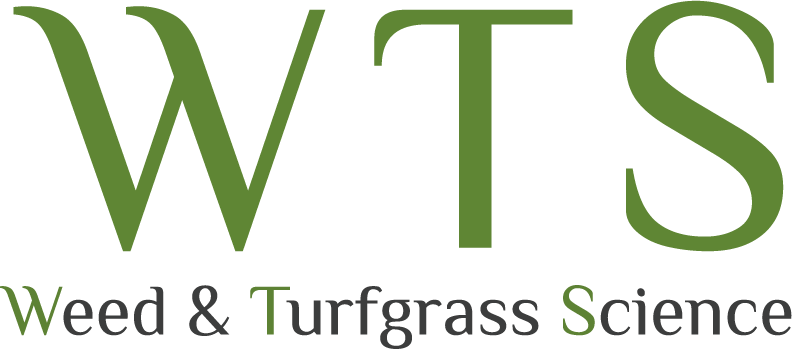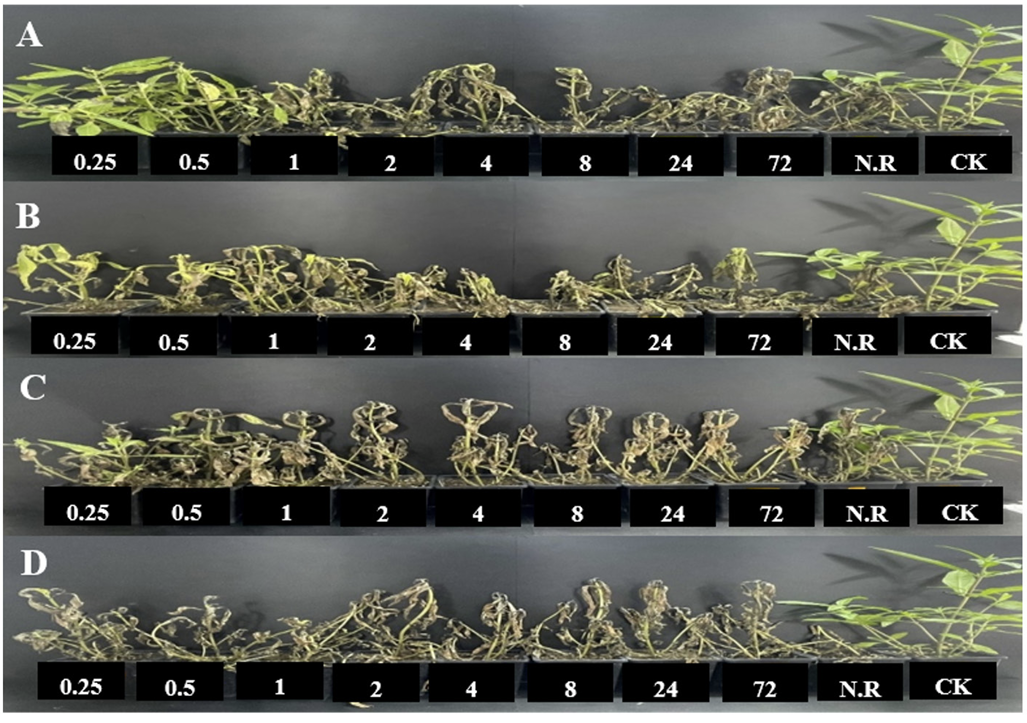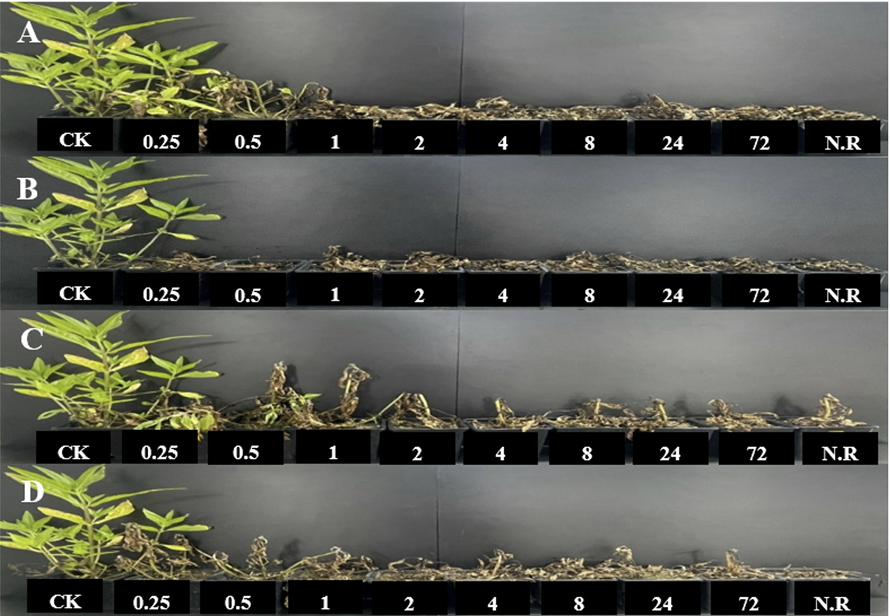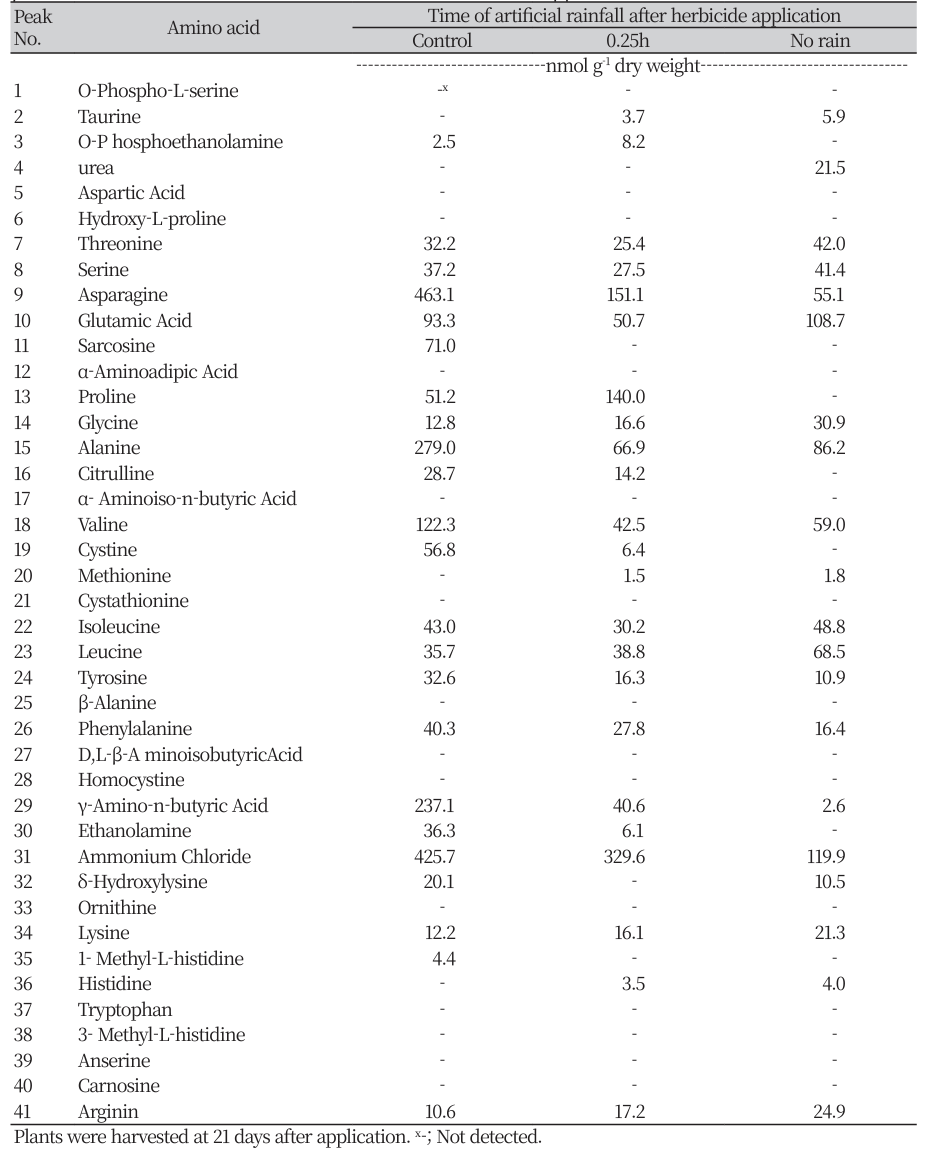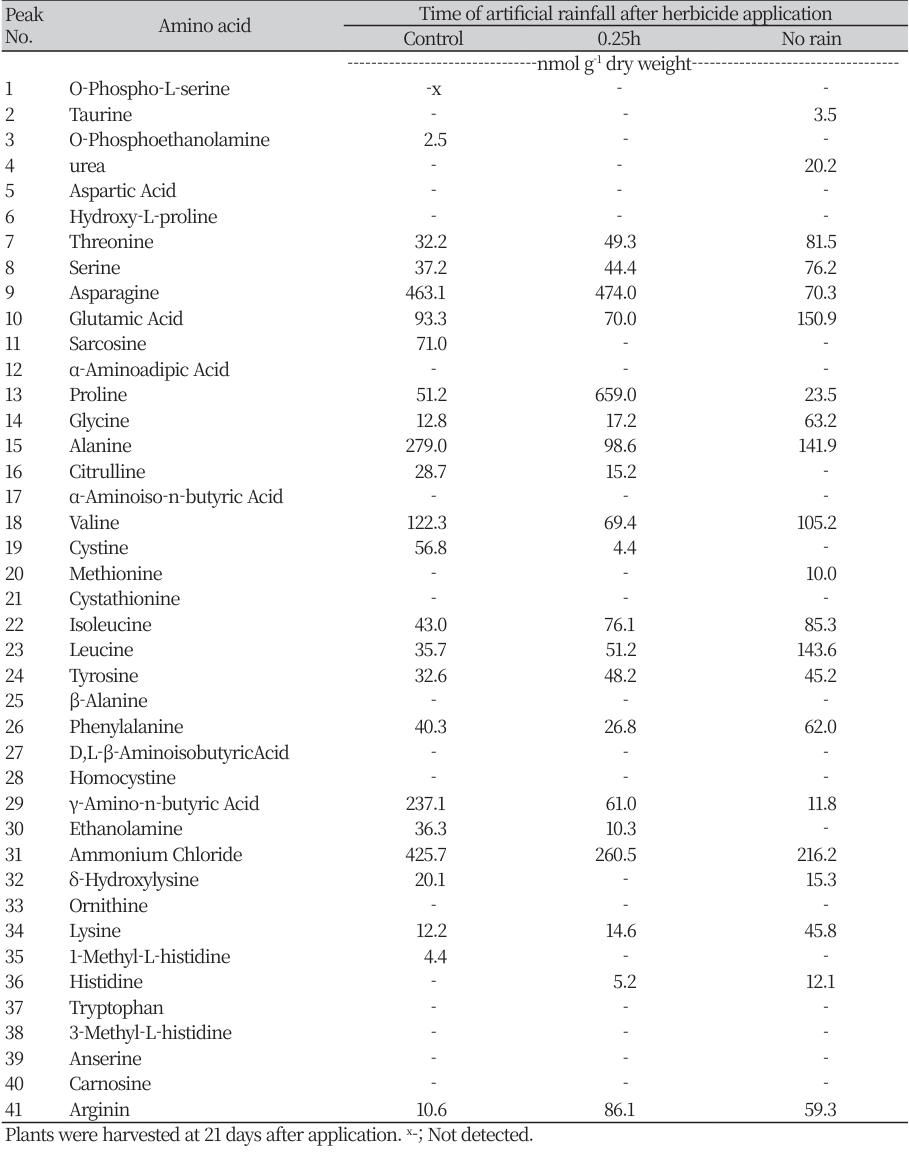서론
경엽처리형 제초제는 접촉 또는 침투 이행하여 제초활성을 발현한다. 제초활성의 발현은 처리한 제초제가 식물체 내로 흡수 및 이행되어 목표로 하는 작용점에 축적되어 나타난다(Deuber, 1982). 경엽처리 제초제의 경우 제초제 처리 후 비산되거나 휘발되지 않은 성분이 경엽을 통해 식물체 내로 침투를 통해 축적되는데 침투를 위한 일정 시간이 필요하며 식물체 표면에 유효농도 유지의 시간이 길어질수록 약효의 발현이 증가한다(Willis et al., 1987). 제초제의 흡수는 잎 큐티클층을 통과하는 양에 의해 제한되며(Deuber, 1982), 환경 조건, 제초제의 특성, 잡초 종에 기인하며 흡수량 감소는 곧바로 제초제의 효과 저하로 이어진다(Souza et al., 2011). 특히 강우는 제초제의 잔효성을 좌우하는 매우 중요한 환경인자로 알려져 있으며 식물 표면에 잔류하는 제초제의 물리적 소실, 활성 성분의 전위, 희석 농도, 흡수율에 영향을 미칠 수 있다(Pedrinho Junior et al., 2002).
농약의 내우성(rain fastness of pesticide)이란 식물체 경엽부에 처리된 농약이 강우에 의해 씻겨 내려가지 않고 견디는 성질을 말한다(Choi and Yu, 2009). 대체로 농약의 내우성은 강우 시간(약제처리 후 강우가 시작될 때까지의 경과시간), 강우형태(강우 강도와 강우량 등), 농약의 특성(제형 등) 및 식물 표면의 성질 등에 영향을 받는다(Richard and Roderick, 1999; Willis et al., 1996). 강우량은 강우 강도와 기간에 의해 결정되며 제초제 처리 직후에 내릴 때 가장 큰 영향을 준다(Kristensen, 1986; Simmons, 1984). 살포 후 약간의 강우 발생 시 제초제가 약간 씻겨 내려가더라도 효능이 향상될 수도(Caseley and Coupland, 1980; Olesen and Kudsk, 1987) 있지만, 더 많은 비가 내라면 제초 활성이 상당히 손실될 수 있다. 제초제의 내우성은 재용해되는 침전물의 감수성과 흡수율과 관련이 있기에 일반적으로 수용성 제초제가 친유성 제초제보다 더 취약한 특성을 나타낸다(McCann and Whitehouse, 1983). 시간 당 0.5 또는 2 mm h-1의 강도로 적용된 비는 벤타존 활성을 감소시키지 않았지만 5 mm h-1에서는 제초제 활성이 40% 감소했다는 연구결과가 있다(Caseley, 1989). 강우량의 증가는 제초제 활성 감소를 일으키지만, 일정 수준 이상의 활성 감소는 발생하지 않았고 단 시간당 몇 mm의 강우 처리는 제초제 활성에 미미한 영향만 미칠 것이라고 밝혀졌다(Anderson, 1985; Miller et al., 1978; Nalewaja, 1988). 강우량 뿐만아니라 제초제 살포와 강우 간의 간격이 효과에 영향을 미친다(Hammerton, 1967).
글리포세이트{N-(phosphonomethyl)glycine}는 광범위한 살초스펙트럼을 가지는 이행형 제초제로 isopropylamine, ammonium, potassium 등이 이온 결합을 통해 염 형태로 제형화되어 사용된다. 특히 포스포네이트는 식물 효소인 5-enolpyruvylshikimate-3-phosphate synthase (EPSP)를 억제하여 작용한다(Maeda and Dudareva, 2012; Casida, 2017). 글리포세이트는 식물과 미생물에서 방향족 아미노산 페닐알라닌, 티로신 및 트립토판을 생성하는 시키메이트 경로(shikimate pathway)를 방해한다(Funke et al., 2006). 글리포세이트는 shikimate-3-phosphate(S3P)와 phosphoenolpyruvate 반응을 촉매하여 EPSP를 억제하여 shikimate pathway를 차단한다(Steinrucken and Amrhein, 1980). EPSP 합성 효소를 억제하면 식물 조직에 shikimate가 축적됨으로 인한 증가된 탄소 공급이 다른 공정에서의 탄소 결핍으로 이어져 결국 식물은 고사된다(Hock and Elstner, 2004). 글루포시네이트(Phosphinothricin, PPT)는 여러 종의 스트렙토마이세스 토양 박테리아에 의해 생성되는 자연 발생 광범위 제초제이고 비선택적 접촉형 제초제로 일부 전신 작용을 한다. PPT는 글루타메이트의 유사체이며 식물의 글루타민 합성효소(GS)를 비가역적으로 억제한다(Wild et al., 1987). 글루포시네이트로 처리된 식물은 틸라코이트 루멘에 암모니아가 축적되어 광인산화 결합이 해제되어 죽는다(Duke, 2014). PPT는 대기조건에서는 광합성을 빠르게 억제하나 광흡수가 일어날 수 없는 조건에서는 광합성 저해율이 없거나 미미하다. 두 조건 모두에서 PPT에 의한 GS의 억제로 인해 NH4+ 축적이 일어난다. PPT에 의한 NH4+ 축적이 광합성 저해의 주요 원인이 될 수는 없지만 광흡수와 관련된 과정에 중심적인 역할을 한다는 것을 나타낸다. PPT는 글루타민, 글루타메이트, 아스파르트산염, 세린 및 글리신의 큰 감소를 유발한다 (Wendler and Wild, 1990).
한련초(Eclipta prostrata)는 false daisy 등으로 불리는 국화과 한해살이풀로 전 세계적으로 널리 퍼져 있고 주로 습한 곳(습지, 논둑 등)에서 흔히 자란다. 한련초에는 coumestans, polypeptides, polyacetylenes, thiophene derivatives, steroids, sterols, triterpenes, flavonoids 등 다양한 식물성 화학물질을 포함하고 있다(Chung et al., 2017). 몇 가지 초종에 대하여 글리포세이트 효과에 미치는 강우량의 영향에 관한 연구되었다(Jakelaisis et al., 2001; Pedrinho Junior et al., 2002; Roman, 2001). 강우에 대한 제초제 2,4-D의 효과에 대한 연구도 여러 가지 식물(옥수수, 목화, 이삭물수세미 등)에서 연구되었다(Bijanzadeh and Ghadiri, 2006; Cason and Roost, 2011; Everitt and Keeling, 2007, Jakelaiti et al., 2001; Siebert et al., 2004). 보리, 강아지풀류 등 화본과 초종에 대한 강우가 글리포시네이트 암모늄의 효과에 미치는 영향에 관한 연구(Anderson et al., 1993), 광엽잡초 Ageratum conyzoides와 화본과 잡초 Rottboellia exaltata 및 방동사니과 잡초 Cyperus rotundus에 대하여 glyphosate 살포 후 30분 후에 강우 강도를 달리하여 처리한 결과 강우 강도가 증가할수록 제초제 효과가 감소하는 경향을 보였고 시간 당 40 mm의 강우 강도는 20~60%의 약효 감소를 일으켰다(Manik et al., 2020). 식물종 간에 내우성의 차이가 있고 한련초에 대한 인공강우에 의한 제초제 약효 변동에 관한 연구는 진행되지 않았다. 본 연구는 한련초에 대표적인 비선택성 제초제인 글리포세이트와 글루포시네이트 암모늄을 살포 후 인공강우 시기가 효과 변동에 미치는 영향을 파악함으로써 강우 발생에 대한 안전한 제초효과를 확인하고자 실시하였다.
재료 및 방법
식물재료
시험초종 한련초(Eclipta prostrata)의 유묘를 원예용상토(암모니아태 질소 ; <500 mg kg-1, 슈퍼믹스Ⓡ, ㈜농경, Jincheon, Korea)와 밭흙(사양토)을 동일한 비율로 혼합하여 채운 사각 플라스틱 pot (95×95×100mm)에 이식한 후 온실조건(온도 20~30℃, 자연광)에서 개체의 초장이 15.4±0.8 cm 수준에 이르고 5개의 분지가 형성되도록 생육시킨 후 시험에 사용하였다.
시험물질
비선택성 경엽처리제인 glyphosate isopropylamine 41% 액제(glyphosate) 및 glufosinate ammonium 18% 액제(glufosinate)를 시중에서 구입하여 사용하였다. Glyphosate는 1,230, 2,460 g ai ha-1, glufosinate은 540, 1,080 g ai ha-1 약량과 1,200 L ha-1의 물량으로 자동압축분무기 (SH100079, Living angel®, Korea)를 이용하여 경엽처리 하였다. 처리 시 온도는 24.3℃ 였고 습도는 56.0% 였다.
강우처리
인공 강우처리는 사각 큐브(㏓㏓㏐)의 상단 중심부에 5개의 수압노즐(nozzle 151710, Yamaho®, Japan)을 설치하고 동력분무기(THS-100A, Taehwa®, Korea)와 연결하여 실시하였다. 인공 강우처리는 비선택성 제초제 glyphosate 1,230, 540 g ai ha-1, glufosinate 2,460, 1,080 g ai ha-1을 각각 살포한 후 0.25, 0.5, 1, 2, 4, 8, 24, 72 시간에 200 ㎪의 노즐 압력으로 시간 당 15 mm의 강우량으로 인공강우 하였다. 강우량(mm)은 노즐 아래 지상에 간이우량계(47.1008, TFA, Germany)를 배치하여 조절하였다
조사방법
제초제 처리 후 7, 14, 21일에 무처리 대비 생장억제정도를 달관평가(0 ; 효과없음, 100; 완전고사)하고 사진촬영 후 비교하였다. 또한 처리 후 21일에 시험식물의 지상부를 건조기(TremoStable OF-105, DAIHAN®, Korea)에 넣고 70℃에서 72 시간 건조한 후 건물중(dry weight)을 측정하였다.
유리아미노산분석
마쇄된 건조시료 1 g을 5 ㎖ 증류수에서 60℃에서 1시간 동안 추출하고, sulfosalicylic acid 10% 용액 1 ml를 첨가한 후 5,000 rpm으로 30분 동안 원심 분리하였다. 상등액을 채취하여 0.2㎛ filtering하고 45℃에서 농축하였다, 상기 농축 시료를 0.2 M Lithium citrate buffer (pH 2.2) ml로 용해시키고 0.2 ㎛ filtering해주었다. 여과된 시료를 아미노산 자동분석기(Biochrom 30, Biochrom Ltd., England)를 사용하여 분석하였고(Lebedev et al., 2018) 아미노산 함량은 prolin (440 ㎚)을 제외하고 570 ㎚에서 측정하였다. 측정 결과는 n㏖ g dry weight-1으로 표현하였다.
통계처리
실험은 3회 반복으로 수행되었다. 제초제 및 강우 처리 후 시험식물의 생육변화는 무처리 대비 억제정도(inhibition %)로 환산하여 나타냈으며 그래프는 SigmaPlot (SigmaPlot 12.5, SYSTAT Software Inc, San Jose, CA, USA)을 사용하여 구하였고, 통계분석은 R statistics (R-4.1.2, 2021)을 이용하여 던컨다중 검증(Duncan's multiple range test) 방법으로 5% 유의수준에서 검증하였다. Glyphosate와 glufosinate 살포 후 LT50값(50% 생육억제하는데 걸리는 강우시간)은 비선형회귀분석(y=min+(max-min)/(1+(x/ LT50)^Hillslope)하였다(Seefeldt et al., 1995). 이 때 4 parameter는 최솟값(min), 최댓값(max), 50% 소요시간(LT 0), 기울기(Hillslope) 등을 적용하였다. 비선형회귀분석을 통해 구해진 LT50과 기울기 값으로 LTF=(F/100-F)1/ H * LT50을 통해 LT90을 산출하였다.
결과 및 고찰
인공강우에 의한 달관평가 비교
비선택성 제초제 처리 후 시간에 따른 강우처리를 하였을 때 약효의 변동을 확인하기 위해 glyphosate는 1,230, 2,460 g ai ha-1 , glufosiante는 540, 1,080 g ai ha-1 약량을 경엽처리 하였다. 인공강우는 제초제 처리 후 0.25, 0.5, 1, 2, 4, 8, 24, 72 시간에 처리해주었다. 처리 후 7일에서 수행된 첫 번째 평가에서 제초제 처리 후 인공강우 실시에 의해 정도의 차이는 있었지만 모든 처리구에서 약효가 발현되었다. 인공강우 무처리구에서 glyphosate 1,230 g ai ha-1과 2,460 g ai ha-1은 각각 46.7%, 53.3%였으며 glufosinate는 각각 51.7%, 56.7%의 방제효과를 보였다. Glyphosate 1,230 g ai ha-1 처리 후 인공 강우 실시 2 시간 이전의 시간에서는 35.0% 이하의 저조한 방제효과를 보였다. 제초제 처리와 인공강우 사이의 간격의 증가함에 따라 방제효과는 비례하게 증가하는 것으로 나타났다(Table1, Fig.1). 처리 후 14일에서 인공강우 실시 0.25와 0.5 시간에서 glyphosate 1,230 g ai ha-1과 glufosinate 540 g ai ha-1 은 각각 38.3, 65.0%와 63.3, 73.3%의 방제효과를 보였다. 약제처리 후 강우처리 1 시간 이후의 모든 처리구에서 100% 방제효과를 보였다(Table 2, Fig. 2). 처리 후 21일에서는 인공강우 0.25와 0.5 시간에서 glyphosate 1,230 g ai ha-1와 glufosinate g ai ha-1는 각각 35.0, 65.0%와 63.3, 63.3%의 방제효과를 보였고 일부 재생된 것을 확인할 수 있었다. 각 제초제 배량의 모든 처리구에서 100% 방제효과를 보였다. 약제처리 1 시간 이후의 인공강우는 한련초에 대한 glyphosate와 glufosinate의 기준량 처리는 약효 변동에 영향을 미치지 않는 것을 확인하였고(Table 3, Fig. 3), 이는 결명자(Senna obtusifolia) 경엽부에 glyphosate와 glufosinate 처리한 후 강우처리 시기를 달리한 결과, glyphosate와 glufosinate의 경우 15분 이후의 강우처리는 제초효과 변동에 영향을 주지 않았다라는 연구결과(Souza et al., 2014)와 유사하였다. 그리고 한련초에 대한 내우성은 glyphosate가 glufosinate보다 더 높은 것을 확인하였다. Glyphosate 처리 후 30분 후에 강우 강도를 달리하여 처리한 결과 강우 강도가 증가할수록 제초제 효과가 감소하는 경향을 보였고 시간 당 40 mm의 강우 강도는 20~60%의 약효 감소를 일으켰다는 연구결과(Manik et al., 2020)를 통해 추가로 강우 강도를 달리한 연구 또한 필요할 것으로 사료된다.
Table 1
Visual effect of glyphsate isopropylamine and glufosinate ammonium foliar application on Eclipta prostrata on 7DAA in a greenhouse condition.

Table 2
Visual effect of glyphsate isopropylamine and glufosinate-ammonium foliar application on Eclipta prostrata on 14DAA in a greenhouse condition.

Table 3
Visual effect of glyphsate isopropylamine and glufosinate-ammonium foliar application on Eclipta prostrata on 21DAA in a greenhouse condition.

인공강우에 의한 건물중 비교
처리 후 21일차 달관평가 종료 후 70℃에서 72 시간 건조한 후 건물중(dry weight)을 측정하였다. Glyphosate 1,230 g ai ha-1과 glufosinate 540 g ai ha-1 처리 후 인공강우를 실시하였을 때 각각 0.25 시간에서는 무처리대비 67.4%, 53.1%였고, 0.5 시간에서는 44.8%, 34.5%였다. 그리고 강우 무처리구에서는 18.2%와 14.3%로 나타났다(Fig. 4). 이는 달관평가의 결과와 유사하게 제초제 처리와 인공강우 사이의 간격이 증가할수록 건물중은 줄어드는 것을 확인할 수 있었고, 21 DAA의 똑같은 100%의 방제효과를 나타내었던 처리구라도 초기에 발생한 약효 변동의 정도에 따라 무처리 대비 건물중의 차이가 발생하는 것을 확인하였다.
Fig. 4
Dry weight (% of control) of Eclipta prostrata 21 days after application of glyphosate isopropylamine and glufosinate ammonium foliar treatment, for time of artificial rainfall after herbicide application(hour). A;glyphosate isopropylamine 1,230 g ai ha-1, B;glyphosate isopropylamine 2,460g ai ha-1, C;glufosinateammonium 540 g ai ha-1, D;glufosinate-ammonium 1,080g ai ha-1. Bars on the graph is standard deviation a~f: Different letters show significant differences at the level of 5% according to Duncan’s multiple range test.
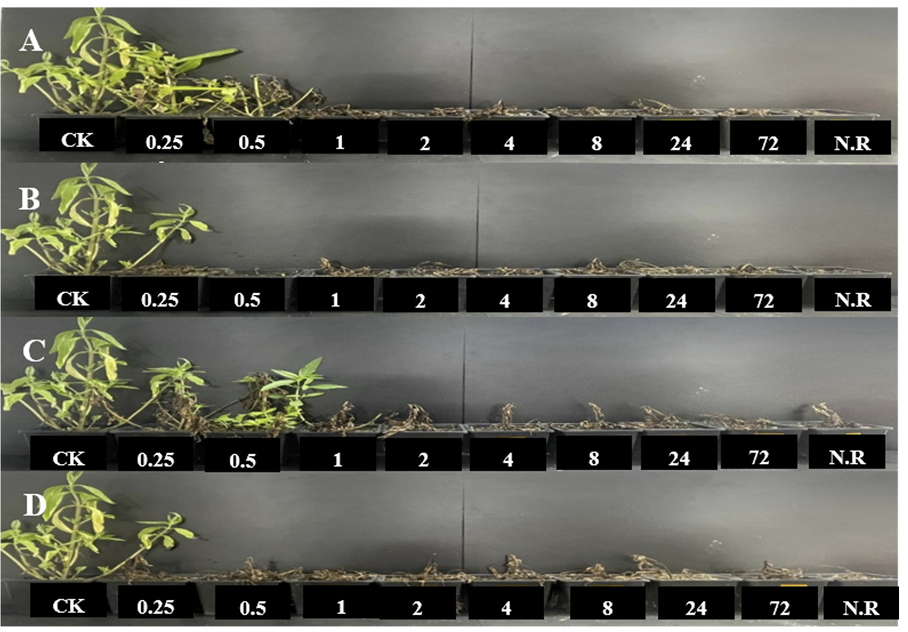
인공강우에 의한 LT50와 LT90비교
Glyphosate와 glufosinate를 한련초에 살포하였을 때의 LT50을 비선형회귀분석y=min+(max-min)/(1+(x/LT50)^Hillslope)을 하였다(Fig. 5). Glyphosate 1,230 g ai ha-1 처리 후 한련초의 50% 방제효과를 나타내는 인공강우의 간격은 0.35 시간이고 glufosinate은 0.21 시간이었다. 계산식 LTF=(F/100-F)1/H*LT50을 통해 LT50과 기울기를 통해 LT90을 산출한 결과, glyphosate 1,230g ai ha-1 처리는 0.91 시간과 glufosinate 540 g ai ha-1은 2.36 시간이었다(Table 4).
Fig. 5
Herbicidal activity of glyphosate isopropylamine(A) and glufosinate-ammonium(B) foliar treatment on Eclipta prostrata for time of artificial rainfall after herbicide application(hour). Bars on the graph is standard deviation. A four-parameter logistic curve, y=min+(max-min)/(1+(x/LT50)^Hillslope), was fit to the herbicidal activity., parameter estimates are given in table 4.
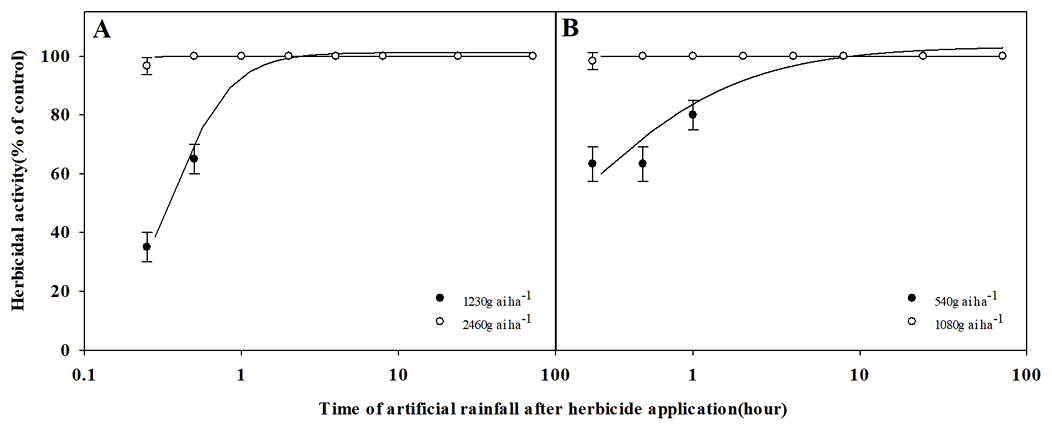
Table 4
Parameter estimates from logistic curve for herbicidal activity of glyphosate isopropylamine and glufosinate-ammonium foliar treatment on Eclipta prostrata.

유리 아미노산 분석
아미노산 생합성 저해 기작을 가진 glyphosate와 glufosinate를 처리 후 인공강우 실시의 시간대에 따른 한련초의 유리 아미노산 함량의 감소를 확인하였다. 총 유리 아미노산 함량은 무처리에 비해 인공강우 0.25 시간과 강우 무처리구에서 감소를 확인하였다. Glyphosate 1,230 g ai ha-1 처리는 인공강우 0.25 시간에서 무처리 대비 49.7%, 강우 무처리구에서 73.8% 감소하였다. Glufosinate 540 g ai ha-1 처리는 인공강우 0.25 시간에서 11.5%, 강우 무처리구에서는 43.5% 감소하였다(Fig. 6). Glyphosate는 식물과 미생물에서 방향족 아미노산 페닐알라닌, 티로신 및 트립토판을 생성하는 시키메이트 경로(shikimate pathway)를 방해한다(Funke, 2006). Glyphosate가 저해한다고 알려져 있는 페닐알라닌, 티로신 그리고 트립토판(Maeda and Dudareva, 2012) 중 트립토판의 경우 모든 처리구에서 검출되지 않았다. 페닐알라닌의 경우 무처리 대비 인공강우 0.25 시간에서 31.9%, 강우 무처리에서 59.4% 감소하였다. Glufosinate는 글루타메이트의 유사체이며, 식물의 GS를 비가역적으로 억제한다(Duke, SO, 2014). GS는 글루탐산과 NH3의 축합을 촉매하여 글루타민을 형성하게 되는데(Liaw et al., 1995) glufosinate의 처리를 통해 글루타민의 함량의 변화는 직접적으로 확인할 수 없었다. 하지만 글루타민의 전구물질인 글루탐산의 함량이 0.25 시간에서는 70.0 nmol g-1, 강우 무처리구에서는 150.9 nmol g-1로 제초제 처리와 인공강우 실시 간에 간격이 늘어남에 따라 증가하는 것을 확인할 수 있었다(Table 5, Table 6). 이는 glufosinate 에 의한 GS저해가 글루탐산이 글루타민으로 전환되지 못하고 축적된 결과라고 추측된다(Duke, 2014). 아스파라긴의 경우, 강우 0.25 시간에서 102.4%로 약간 상승하였지만 강우 무처리에서는 대비 84.8% 감소하였다. 아스파라긴은 아스파라긴 합성효소에 의해 식물체내에 아스파르트에 글루타민이나 암모니아가 중합되어 생합성 된다고 알려져 있는데 glufosinate에 의한 글루타민의 함량의 변화에 의한 결과인 것으로 추측된다(Reitzer, 2004). 그러나 비선택성 제초제 처리에 의한 유리 아미노산 함량 변화는 아미노산 종류에 따라 복잡한 양상을 보여 이론에 모두 부합하는 경향으로 설명하거나 구체적인 해석을 하기에는 다소 무리한 것으로 판단되었다.
Fig. 6
Effect of glyphosate isopropylamine 1,230 g ai ha-1(A) and glufosinate-ammonium 540 g ai ha-1(B) on total free amino acid contents in the shoots of Eclipta prostrata in different time of artificial rainfall after herbicide application. Different letters show significant differences at the level of 5% according to Duncan’s multiple range test.
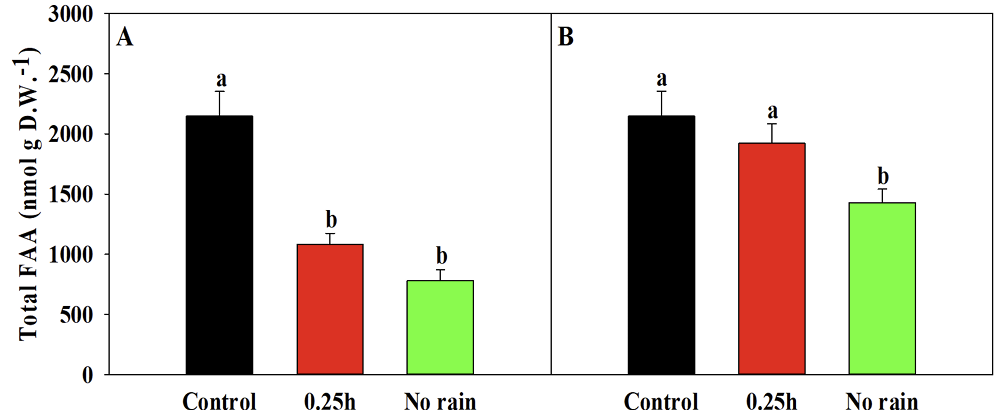
요약
본 연구에서는 비선택성 제초제 살포 후 강우 시기가 효과 변동에 미치는 영향을 알아보고 잡초와 작물에 대한 약효 및 약해 변동을 조사하여 그 정도를 이해하고 농업기상환경에 대처하기 위해 한련초를 대상으로 실시하였다. 한련초 잎에 비선택성 제초제 glyphosate isopropylamine 41% 액제(glyphosate) 1,230 및 2,460 g ai ha-1와 glufosinate ammonium 18% 액제(glufosinate) 540 및 1,080 g ai ha-1를 처리한 후 0.25, 0.5, 1, 2, 4, 8, 24 및 72 시간에 인공강우 하였다. 약제처리 후 7, 14 및 21일에 달관평가, 건물중 및 유리 아미노산 함량을 비교하였다. 약제처리 후 21일째 조사결과, glyphosate 1,230 g ai ha-1 처리 후 인공강우 1시간, glufosinate 540 g ai ha-1는 인공강우 2 시간 이후 처리 시 100% 방제되는 것을 확인할 수 있었으며 이때 LT90은 각각 0.91, 2.36 시간이었다. Glyphosate 1,230 g ai ha-1처리 후 유리 아미노산을 분석하였을 때, 페닐알라닌은 인공강우 0.25 시간에서 무처리 대비 31.9%, 인공강우 무처리구에서는 59.4% 감소하였고 티로신은 인공강우 0.25 시간에서 50%, 인공강우 무처리에서는 66.7% 감소하였다. Glufosinate 540 g ai ha-1 처리 후 유리 아미노산은 분석하였을 때, 아스파라긴은 인공강우 0.25 시간에서 무처리 대비 102.4% 상승하였지만 인공강우 무처리에서는 84.8% 감소하였다. 아미노산 생합성 저해제로 알려진 시험 약제 처리 후 인공강우 시간에 따른 유리 아미노산을 분석한 결과 일정 수준의 함량 감소를 확인하였다 이러한 결과는 최근 강우 패턴 등 농업 기상 환경을 고려한 효율적인 잡초 관리에 참고자료로 사용될 것으로 판단된다.
Acknowledgments
This work was supported by Gyeongsang National University Grant in 2023 to Sung Hwan Choi.
Authors Information
Hyung Woo Kim, Division of Horticulture, Gyeongsang National University, Master Student
Sang-Hyun Lee, Division of Horticulture, Gyeongsang National University, Master Student
Yu-Jin Song, Division of Horticulture, Gyeongsang National University, Master Student
In-Mo Kim, Division of Horticulture, Gyeongsang National University, Master Student
Myung-Soo Jin, Division of Horticulture, Gyeongsang National University, Master Student
Jeung Joo Lee, Department of Plant Medicine, Gyeongsang National University, Professor
Sung Hwan Choi, Division of Horticulture, Gyeongsang National University, Professor
